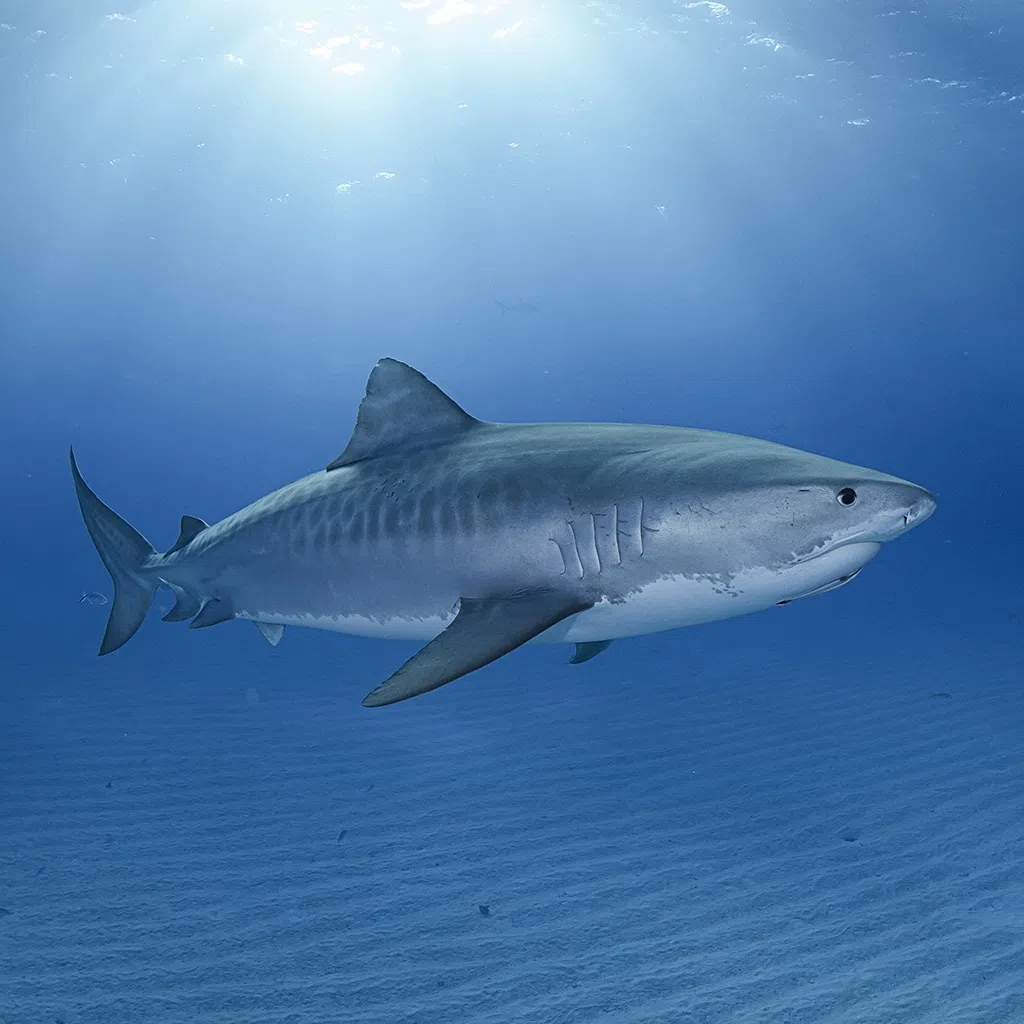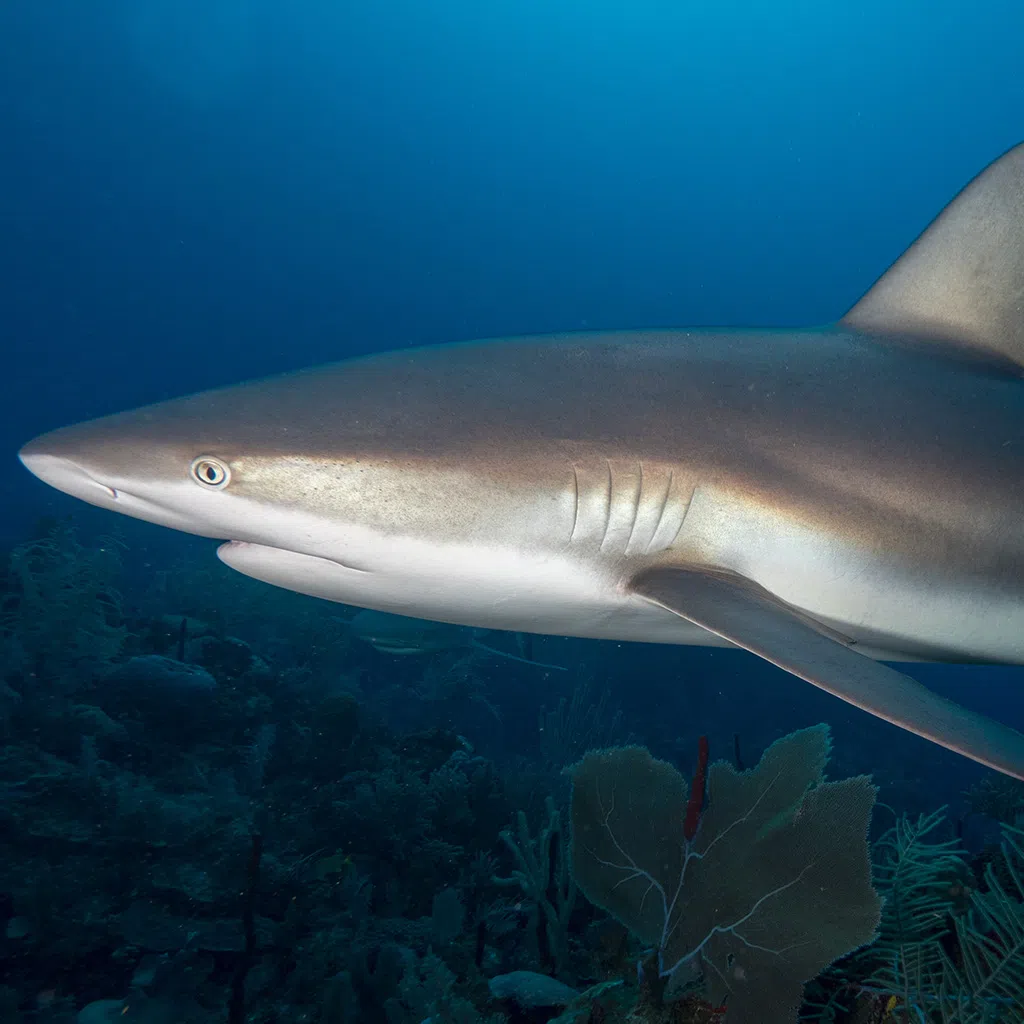
Galapagos
Carcharhinus Galapagensis
A species of requiem shark, in the family Carcharhinidae, found worldwide. This species favors clear reef environments around oceanic islands, where it is often the most abundant shark species. A large species that often reaches 9-10 ft. Galapagos sharks are active predators often encountered in large groups. Reproduction is viviparous, with females bearing litters of 4-16 pups every 2-3 years. The most commonly seen shark, their behavior is bold, inquisitive and persistent.

Grey Reef Shark
Carcharhinus Amblyrhynchos
A species of requiem shark, in the family Carcharhinidae. One of the most common reef sharks in the Indo-Pacific most individuals are less than 6 ft. They are fast-swimming, agile predators. An aggressive demeanor enables them to dominate many other shark species on the reef, despite their size. They gather in groups of up to 20. They were the first shark species known to perform a threat display, a behavior warning that it is prepared to attack.

Tiger Shark
Galeocerdo Cuvier
A species of requiem shark, the only member of the genus Galeocerdo. Attains length of up to over 16 ft. Found in tropical and temperate waters, especially in central Pacific islands. Name derives from the dark stripes down its body resembling a tiger's pattern. Solitary, mostly nocturnal hunter, the Tiger shark is an apex predator having a reputation for eating anything including other sharks and injured whales.
Often found close to the coast in tropical and subtropical waters throughout the world, its behavior is primarily nomadic, but is guided by warmer currents, it stays closer to the equator throughout colder months. Recorded at depths from 10 ft to 3,000 ft. Females mate once every 3 years birthing 10-80 pups. Attacks by tiger sharks in Hawaiian waters have been shown to increase between September and November, when tiger shark females are believed to migrate to give birth.

Black Tip Shark
Carcharhinus Melanopterus
A species of requiem shark, in the family Carcharhinidae, easily identified by the prominent black tips on dorsal and caudal fins. Among the most abundant sharks inhabiting tropical reefs of the Indian and Pacific Oceans They typically reach a length of 5 ft, and have extremely small home ranges, exhibit strong site fidelity keeping to same local area for several years. Timid and skittish, they are difficult to approach, and seldom poses a danger to humans.

Scalloped Hammerheads
Sphyrna lewini
The scalloped hammerhead is a species of hammerhead shark in the family Sphyrnidae. It was originally known as Zygaena lewini. The Greek word sphyrna translates into "hammer" in English, referring to the shape of this shark's head, which is its most distinguishing characteristic.
The shark's eyes and nostrils are at the tips of the extensions. It is a fairly large hammerhead, but is still smaller than both the great and smooth hammerheads.

Smooth Hammerhead
Sphyrna zygaena
The smooth hammerhead is a species of hammerhead shark in the family Sphyrnidae. It was originally known as Zygaena lewini. This species is named "smooth hammerhead" because of the distinctive shape of the head, which is flattened and laterally extended into a hammer shape (called the "cephalofoil"), without an indentation in the middle of the front margin (hence "smooth").
Unlike other hammerheads, this species prefers temperate waters and occurs worldwide at medium latitudes. In the summer, these sharks migrate towards the poles following cool water masses, sometimes forming schools numbering in the hundreds to thousands.

Silky Shark
Carcharhinus falciformis
Also known by numerous names such as blackspot shark, gray whaler shark, olive shark, ridgeback shark, sickle shark, sickle-shaped shark and sickle silk shark, is a species of requiem shark, in the family Carcharhinidae, named for the smooth texture of its skin.
It is one of the most abundant sharks in the pelagic zone, and can be found around the world in tropical waters.

Sandbar Shark
Carcharhinus plumbeus
Also known as the brown shark or thickskin shark, is a species of requiem shark, and part of the family Carcharhinidae, native to the Atlantic Ocean and the Indo-Pacific. It is distinguishable by its very high first dorsal fin and interdorsal ridge. It is not to be confused with the similarly named sand tiger shark, or Carcharias taurus.
In spite of their large size and similar appearance to other dangerous sharks such as bull sharks, Sandbars are not considered to be dangerous to people. Very few, if any attacks are attributed to sandbar sharks. As a result, they are considered one of the safest sharks to swim with and are popular sharks for aquaria.
Book Your Adventure Today.
Embrace the thrill of open ocean, cage-free shark diving with Hawaii Adventure Diving, the top-rated adventure outfit on the island with a perfect 5-star Google rating. With a passion that extends beyond business, our highly-skilled crew delivers transformative experiences, offering unparalleled service where safety, education, and an unforgettable journey are our hallmarks.

